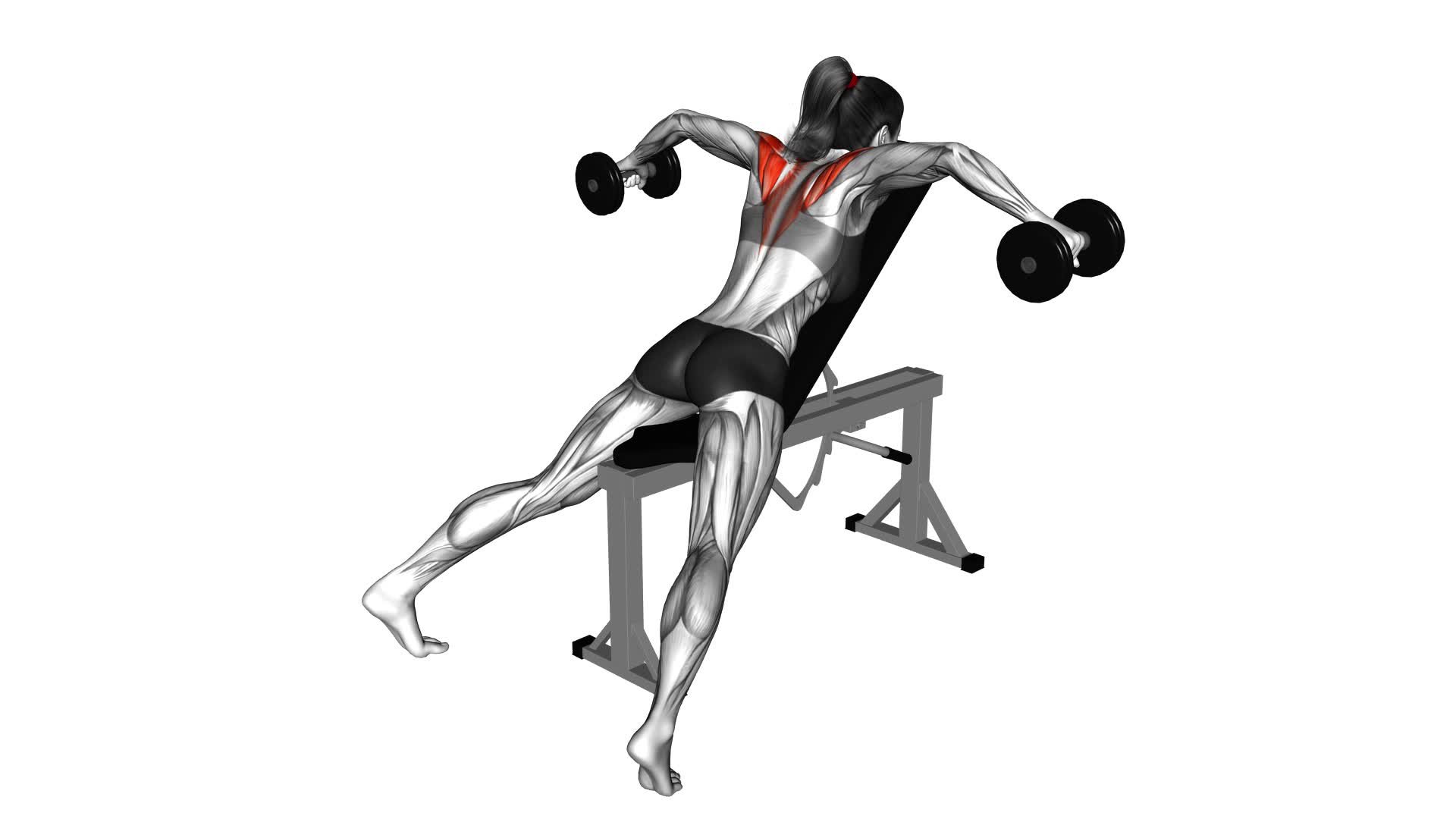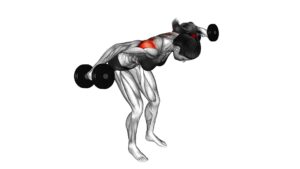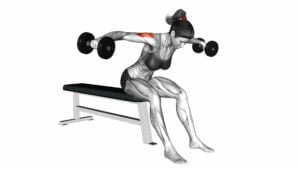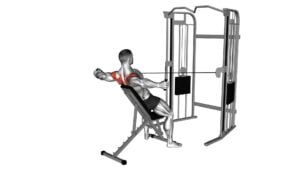Dumbbell Incline Rear Fly (female) – Video Exercise Guide & Tips

Are you looking to tone and strengthen your upper back and shoulders? Look no further than the dumbbell incline rear fly.
Watch This Exercise Video
This exercise targets those hard-to-reach muscles, giving you a more defined and sculpted look.
With just a set of dumbbells and a bench, you can easily incorporate this exercise into your routine.
Follow our video guide and tips to ensure proper form and technique, and get ready to challenge yourself for maximum results.
Key Takeaways
- Targets and strengthens muscles in the upper back and shoulders
- Enhances posture and improves overall upper body strength
- Dumbbells are essential equipment for this exercise
- Focus on shoulder alignment and core engagement for stability
Benefits of the Dumbbell Incline Rear Fly
One of the main benefits of the Dumbbell Incline Rear Fly is that it targets and strengthens the muscles in your upper back and shoulders. This exercise specifically works the posterior deltoids, rhomboids, and trapezius muscles. By performing the Dumbbell Incline Rear Fly with proper form, you can enhance your posture and improve overall upper body strength.
Using the correct form is crucial when performing the Dumbbell Incline Rear Fly. It's important to have a slight bend in your knees, hinge forward at the hips, and keep your back flat. Initiate the movement by squeezing your shoulder blades together as you raise the dumbbells out to the sides. Make sure to maintain a controlled motion and avoid using momentum to perform the exercise.
In addition to the benefits of proper form, there are alternative exercises that can also target the same muscle groups. These include the bent-over dumbbell fly, cable face pull, and seated rear delt fly. Incorporating these exercises into your workout routine can provide variety and help prevent muscle imbalances.
To maximize the benefits of the Dumbbell Incline Rear Fly, it's important to prioritize proper form and gradually increase the weight as you get stronger. Remember to consult with a fitness professional if you have any concerns or questions about incorporating this exercise into your routine.
Equipment Needed for This Exercise
To perform the Dumbbell Incline Rear Fly, you'll need a pair of dumbbells. These dumbbells should be challenging enough to provide resistance but still allow you to maintain proper form throughout the exercise.
If you don't have access to dumbbells, you can use alternative equipment such as resistance bands or kettlebells to target the same muscle groups.
Essential Equipment for Exercise
You will need dumbbells for this exercise. Dumbbells are a versatile piece of exercise equipment that can be used for various strength training exercises. They're a must-have in your workout gear collection.
Dumbbells come in different weights, allowing you to choose the appropriate resistance for your fitness level and goals. They're compact and easy to handle, making them ideal for home workouts or gym sessions.
When performing the Dumbbell Incline Rear Fly exercise, the dumbbells will help target and strengthen your upper back muscles.
Investing in a set of dumbbells will give you the freedom to incorporate a wide range of exercises into your fitness routine, making them an essential piece of equipment for any exercise enthusiast.
Alternative Equipment Options
To perform the Dumbbell Incline Rear Fly exercise, you'll need alternative equipment options. If you don't have access to dumbbells or prefer to use different equipment, here are some modifications for beginners:
- Resistance bands: These bands provide tension and can be used instead of dumbbells. They come in different levels of resistance, allowing you to gradually increase the intensity of the exercise.
- Water bottles: Fill up two water bottles and use them as weights. They may not be as heavy as dumbbells, but they can still provide some resistance for beginners.
- Soup cans: Grab a couple of cans from your pantry and use them as makeshift weights. They're lighter than dumbbells, making them suitable for beginners.
- Backpack: Fill a backpack with books or other heavy objects and wear it while performing the exercise. This adds extra weight and increases the intensity.
- Bodyweight: If you're just starting out, you can perform the exercise without any equipment. Focus on perfecting your form and gradually increase the difficulty as you gain strength.
These alternative equipment options provide beginners with different ways to perform the Dumbbell Incline Rear Fly exercise. Experiment with different options to find the one that suits you best.
Proper Form and Technique
To ensure proper form and technique during the dumbbell incline rear fly exercise, it's important to focus on shoulder alignment. Keep your shoulders pulled back and down throughout the movement to avoid any unnecessary strain.
Additionally, engage your core muscles to maintain stability and prevent excessive arching of the lower back.
Remember to perform the exercise with controlled movements, emphasizing the squeeze of the shoulder blades at the top of the motion for maximum effectiveness.
Shoulder Alignment During Exercise
Maintain proper shoulder alignment during the dumbbell incline rear fly exercise to maximize effectiveness and prevent injury. Here are some important tips to ensure proper shoulder alignment:
- Keep your shoulders down and back throughout the exercise to promote good posture and engage the correct muscles.
- Avoid shrugging your shoulders or hunching forward, as this can strain the neck and upper back.
- Maintain a neutral spine by engaging your core muscles and keeping your chest lifted.
- Ensure proper shoulder mobility by performing dynamic warm-up exercises before starting the exercise.
- Focus on muscle activation by squeezing your shoulder blades together at the top of the movement and controlling the weights on the way down.
Core Engagement for Stability
Engage your core for stability and proper form during the dumbbell incline rear fly exercise. Core stability is essential for maintaining balance and preventing any unwanted movements during the exercise.
To engage your core, focus on contracting your abdominal muscles and drawing your belly button towards your spine. This will create a solid foundation and provide support to your spine. Additionally, squeezing your glutes can also help in stabilizing your hips and maintaining a neutral spine position.
By engaging your core, you won't only improve your stability but also enhance the effectiveness of the exercise.
Now that you understand the importance of core engagement, let's move on to the next section about the importance of controlled movement.
Importance of Controlled Movement
When performing the dumbbell incline rear fly exercise, it's crucial to focus on maintaining controlled movement to ensure proper form and technique. By emphasizing controlled movement, you can reap several benefits and maximize the effectiveness of this exercise:
- Reduced risk of injury: Controlled movement helps prevent jerky or sudden motions that can strain muscles or joints.
- Increased muscle activation: By moving slowly and deliberately, you engage the targeted muscles more effectively, leading to better results.
- Improved mind-muscle connection: Paying attention to controlled movement enhances your ability to connect with and activate the specific muscle group you're targeting.
- Enhanced stability and balance: Controlled movement requires core engagement and stability, helping you maintain balance throughout the exercise.
- Better overall performance: By focusing on controlled movement, you develop better body awareness and coordination, which can translate into improved performance in other exercises or activities.
Variations to Challenge Your Muscles
To target different areas of your muscles and intensify your workout, try incorporating these variations of the dumbbell incline rear fly exercise.
For beginners, you can start with a lighter weight or even use resistance bands instead of dumbbells. This will help you develop proper form and technique before progressing to more advanced variations.
Another option for beginners is to perform the exercise on a flat bench instead of an incline bench. This will still engage your rear deltoids, but with less intensity.
For those looking for advanced variations, you can increase the weight of the dumbbells or use a weighted vest to add extra resistance. This will challenge your muscles even more and promote further strength and muscle growth.
Another advanced variation is to perform the exercise on an unstable surface, such as a stability ball or a Bosu ball. This will engage more stabilizer muscles and enhance your overall balance and core strength.
Remember to always listen to your body and choose variations that suit your fitness level. It's important to progress gradually and avoid pushing yourself too hard too soon.
Tips for Maximizing Your Results
To maximize your results, incorporate these tips into your dumbbell incline rear fly exercise routine:
- Adjust the incline: Altering the angle of the bench can help target specific muscles. Increase the incline to focus on your upper back and shoulders, or decrease it to engage your lower back and traps.
- Use proper form: Maintain a slight bend in your knees and keep your back straight throughout the exercise. Avoid using momentum or swinging the weights to maximize intensity and prevent injury.
- Engage your core: Contract your abdominal muscles and keep your core tight while performing the exercise. This will help stabilize your body and increase the effectiveness of the movement.
- Mind-muscle connection: Focus on the muscles you're targeting during the exercise. Visualize them contracting as you lift the weights and squeeze them at the top of the movement for maximum engagement.
- Gradually increase weight: As your strength improves, gradually increase the weight of the dumbbells to continue challenging your muscles. This progressive overload will promote muscle growth and enhance your results.
Common Mistakes to Avoid While Performing This Exercise
Watch out for these common mistakes while performing the dumbbell incline rear fly exercise to ensure optimal results. Proper form is crucial for this exercise, so make sure to avoid these errors.
One common mistake is using too much weight. It's important to start with a weight that you can comfortably handle to maintain control and prevent injury.
Another mistake is rounding your back. Keep your back straight and your core engaged throughout the movement to target the correct muscles and maintain proper alignment.
Additionally, avoid swinging your arms or using momentum to lift the weights. This not only reduces the effectiveness of the exercise but also puts unnecessary strain on your shoulders. Instead, focus on controlled movements and a full range of motion.
Lastly, be mindful of your posture. Avoid arching your back or hunching your shoulders forward. Keep your chest up and shoulders back to maintain proper form.
Frequently Asked Questions
How Many Sets and Reps Should I Do for the Dumbbell Incline Rear Fly?
To progress in the dumbbell incline rear fly, it's important to focus on the right sets and reps.
Start with 2 to 3 sets of 8 to 12 reps, using a weight that challenges you but still allows proper form.
As you get stronger, gradually increase the weight or reps.
Avoid common mistakes like using excessive momentum or rounding your back.
Can Men Also Perform the Dumbbell Incline Rear Fly Exercise?
Yes, men can also perform the dumbbell incline rear fly exercise. Gender inclusivity in fitness routines is important, and this exercise is beneficial for both men and women.
It helps strengthen the muscles in your upper back and shoulders. To add variation, you can try different grip positions or use resistance bands instead of dumbbells.
Remember to start with lighter weights and gradually increase as you get stronger.
Is It Necessary to Warm up Before Performing This Exercise?
Before performing the dumbbell incline rear fly, it's important for you to warm up. Warming up has several benefits, such as increasing blood flow to your muscles and reducing the risk of injury. It also prepares your body for the exercise ahead.
Additionally, it's crucial to avoid common mistakes while performing this exercise, like using excessive weight or swinging your body. Focus on maintaining proper form and control for maximum effectiveness.
Can I Substitute Dumbbells With Resistance Bands for This Exercise?
Yes, you can substitute dumbbells with resistance bands for the incline rear fly exercise. Resistance bands offer a different type of resistance that can target your muscles in a unique way.
They can provide a greater range of motion and allow you to adjust the resistance level easily.
Using resistance bands for strength training has benefits such as improving muscular endurance and stability.
How Long Should I Rest Between Sets While Performing the Dumbbell Incline Rear Fly?
When performing the dumbbell incline rear fly, it's important to consider your rest time between sets.
Resting too little can compromise muscle activation, while resting too long can hinder the effectiveness of the exercise.
It's recommended to rest for about 30-60 seconds between sets of the dumbbell incline rear fly.
This allows your muscles to recover and ensures optimal muscle activation during each set.
Remember to listen to your body and adjust the rest time as needed.
Conclusion
The dumbbell incline rear fly is a great exercise for targeting the muscles in your upper back and shoulders. It can help improve posture, strengthen your muscles, and enhance overall upper body strength.
By using proper form and technique, varying the weight and angle, and following the tips provided, you can maximize your results and avoid common mistakes.
Incorporate this exercise into your routine for a stronger and more defined upper body.

Author
Years ago, the spark of my life’s passion ignited in my mind the moment I stepped into the local gym for the first time. The inaugural bead of perspiration, the initial endeavor, the very first surge of endorphins, and a sense of pride that washed over me post-workout marked the beginning of my deep-seated interest in strength sports, fitness, and sports nutrition. This very curiosity blossomed rapidly into a profound fascination, propelling me to earn a Master’s degree in Physical Education from the Academy of Physical Education in Krakow, followed by a Sports Manager diploma from the Jagiellonian University. My journey of growth led me to gain more specialized qualifications, such as being a certified personal trainer with a focus on sports dietetics, a lifeguard, and an instructor for wellness and corrective gymnastics. Theoretical knowledge paired seamlessly with practical experience, reinforcing my belief that the transformation of individuals under my guidance was also a reflection of my personal growth. This belief holds true even today. Each day, I strive to push the boundaries and explore new realms. These realms gently elevate me to greater heights. The unique combination of passion for my field and the continuous quest for growth fuels my drive to break new ground.



